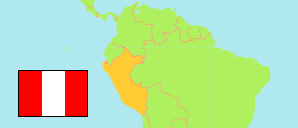
Alto Inambari
District in Puno Region
Contents: Population
The population development of Alto Inambari as well as related information and services (Wikipedia, Google, images).
| Name | Status | Population Census 1993-07-11 | Population Census 2007-10-21 | Population Census 2017-10-22 | Population Projection 2022-06-30 | |
|---|---|---|---|---|---|---|
| Alto Inambari (← Sandia) | District | ... | 7,537 | 7,487 | 7,356 | |
| Puno | Region | 1,079,849 | 1,268,441 | 1,226,936 | 1,226,353 |
Source: Instituto Nacional de Estadística e Informática, Peru (web).
Explanation: The tabulated results of the 2017 census are adjusted for underenumeration. Area figures are computed by using geospatial data.
Further information about the population structure:
| Gender (C 2017) | |
|---|---|
| Males | 4,174 |
| Females | 3,313 |
| Age Groups (C 2017) | |
|---|---|
| 0-14 years | 1,924 |
| 15-64 years | 5,087 |
| 65+ years | 476 |
| Age Distribution (C 2017) | |
|---|---|
| 90+ years | 8 |
| 80-89 years | 74 |
| 70-79 years | 241 |
| 60-69 years | 422 |
| 50-59 years | 763 |
| 40-49 years | 1,059 |
| 30-39 years | 1,108 |
| 20-29 years | 1,327 |
| 10-19 years | 1,204 |
| 0-9 years | 1,280 |
| Urbanization (C 2017) | |
|---|---|
| Rural | 7,487 |
| Literacy (A3+) (C 2017) | |
|---|---|
| yes | 6,109 |
| no | 1,035 |
| Ethnic Group (A12+) (C 2017) | |
|---|---|
| Quechua | 5,103 |
| Aymara | 128 |
| Afro-Peruvian | 241 |
| White | 98 |
| Mestizo | 197 |
| Other group | 69 |
| Religion (A12+) (C 2017) | |
|---|---|
| Catholics | 4,525 |
| Evangelicals | 412 |
| Other religion | 832 |
| No religion | 155 |